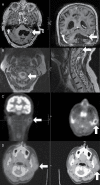Long-term outcomes and late toxicity of adult medulloblastoma treated with combined modality therapy: A contemporary single-institution experience
- PMID: 35671386
- PMCID: PMC9713502
- DOI: 10.1093/neuonc/noac126
Long-term outcomes and late toxicity of adult medulloblastoma treated with combined modality therapy: A contemporary single-institution experience
Abstract
Background: Medulloblastoma (MB) is a rare central nervous system malignancy of adults, with limited contemporary studies to define treatment guidelines and expected late toxicity.
Methods: A single-center, retrospective study was conducted of patients age ≥18 years from 1997-2019 with MB and who were treated with postoperative radiotherapy. Late toxicity was defined as a minimum of 18 months from diagnosis. Overall survival (OS) and progression-free survival (PFS) were characterized using Kaplan-Meier and Cox regression analyses.
Results: Fifty-nine patients met criteria, with median age of 25 years (range 18-62 y) and median follow-up of 6.5 years (range 0.7-23.1 y). At diagnosis, 68% were standard-risk, 88% Chang M0, and 22% with anaplastic histology. Gross total resection was achieved in 75%; median craniospinal irradiation dose was 30.6 Gy (relative biological effectiveness [RBE]), median total dose was 54.0 Gy (RBE), 80% received proton radiotherapy; 81% received chemotherapy. 5 year PFS and OS were 86.5% and 95.8%, respectively; 10 year PFS and OS were 83.9% and 90.7%, respectively. Anaplastic histology was associated with worse PFS (P = .04). Among eight recurrences, 25% presented after 5 years. Most common grade ≥2 late toxicities were anxiety/depressive symptoms (30%), motor dysfunction (25%), and ototoxicity (22%). Higher posterior fossa radiation dose was associated with increased risk of late toxicity, including worse cognitive dysfunction (P = .05).
Conclusions: Adults with MB have favorable survival outcomes, but late failures and toxicity are not uncommon. Better understanding of prognostic factors, possibly from molecular subtyping, may help to define more personalized treatments for patients with high risk of recurrence and long-term treatment sequelae.
Keywords: adult medulloblastoma; late toxicity; medulloblastoma; outcomes.
© The Author(s) 2022. Published by Oxford University Press on behalf of the Society for Neuro-Oncology. All rights reserved. For permissions, please e-mail: journals.permissions@oup.com.
Figures


Similar articles
-
Medulloblastoma in adults : A retrospective single institution analysis.Strahlenther Onkol. 2018 Mar;194(3):225-234. doi: 10.1007/s00066-017-1235-5. Epub 2017 Nov 16. Strahlenther Onkol. 2018. PMID: 29147840 English.
-
Late toxicity following craniospinal radiation for early-stage medulloblastoma.Acta Oncol. 2014 Apr;53(4):471-80. doi: 10.3109/0284186X.2013.862596. Epub 2014 Feb 24. Acta Oncol. 2014. PMID: 24564687 Clinical Trial.
-
A Multi-institutional Comparative Analysis of Proton and Photon Therapy-Induced Hematologic Toxicity in Patients With Medulloblastoma.Int J Radiat Oncol Biol Phys. 2021 Mar 1;109(3):726-735. doi: 10.1016/j.ijrobp.2020.09.049. Epub 2020 Nov 23. Int J Radiat Oncol Biol Phys. 2021. PMID: 33243479
-
Adult medulloblastoma: multiagent chemotherapy.Neuro Oncol. 2001 Jan;3(1):29-34. doi: 10.1093/neuonc/3.1.29. Neuro Oncol. 2001. PMID: 11305414 Free PMC article. Review.
-
The role of radiotherapy in adult medulloblastoma: long-term single-institution experience and a review of the literature.J Neurooncol. 2012 Jan;106(2):315-23. doi: 10.1007/s11060-011-0665-7. Epub 2011 Jul 31. J Neurooncol. 2012. PMID: 21805324 Review.
Cited by
-
Advancing medulloblastoma therapy: strategies and survival insights.Clin Exp Med. 2025 Apr 16;25(1):119. doi: 10.1007/s10238-025-01648-5. Clin Exp Med. 2025. PMID: 40237916 Free PMC article. Review.
-
Impact of partial substitution of cisplatin with cyclophosphamide on acute toxicities in standard-risk medulloblastoma.J Neurooncol. 2025 Sep;174(3):689-697. doi: 10.1007/s11060-025-05098-7. Epub 2025 Jun 10. J Neurooncol. 2025. PMID: 40495013 Free PMC article.
-
Multifocal medulloblastoma in an adult: a case report and review of the literature.J Cancer Res Clin Oncol. 2025 May 15;151(5):166. doi: 10.1007/s00432-025-06215-9. J Cancer Res Clin Oncol. 2025. PMID: 40369375 Free PMC article. Review.
-
Treatment of IDH-mutant glioma in the INDIGO era.NPJ Precis Oncol. 2024 Jul 19;8(1):149. doi: 10.1038/s41698-024-00646-2. NPJ Precis Oncol. 2024. PMID: 39025958 Free PMC article. Review.
-
Diagnosis and management of complications from the treatment of primary central nervous system tumors in adults.Neuro Oncol. 2023 Jul 6;25(7):1200-1224. doi: 10.1093/neuonc/noad038. Neuro Oncol. 2023. PMID: 36843451 Free PMC article.
References
-
- Majd N, Penas-Prado M. Updates on management of adult medulloblastoma. Curr Treat Options Oncol. 2019;20(8):64. - PubMed
-
- Franceschi E, Hofer S, Brandes AA, et al. . EANO-EURACAN clinical practice guideline for diagnosis, treatment, and follow-up of post-pubertal and adult patients with medulloblastoma. Lancet Oncol. 2019;20(12):e715–e728. - PubMed
-
- Brandes AA, Franceschi E, Tosoni A, et al. . Long-term results of a prospective study on the treatment of medulloblastoma in adults. Cancer 2007;110(9):2035–2041. - PubMed
-
- Chan AW, Tarbell NJ, Black PML, et al. . Adult medulloblastoma: prognostic factors and patterns of relapse. Neurosurgery 2000;47(3):623–632. - PubMed
MeSH terms
LinkOut - more resources
Full Text Sources
Miscellaneous

